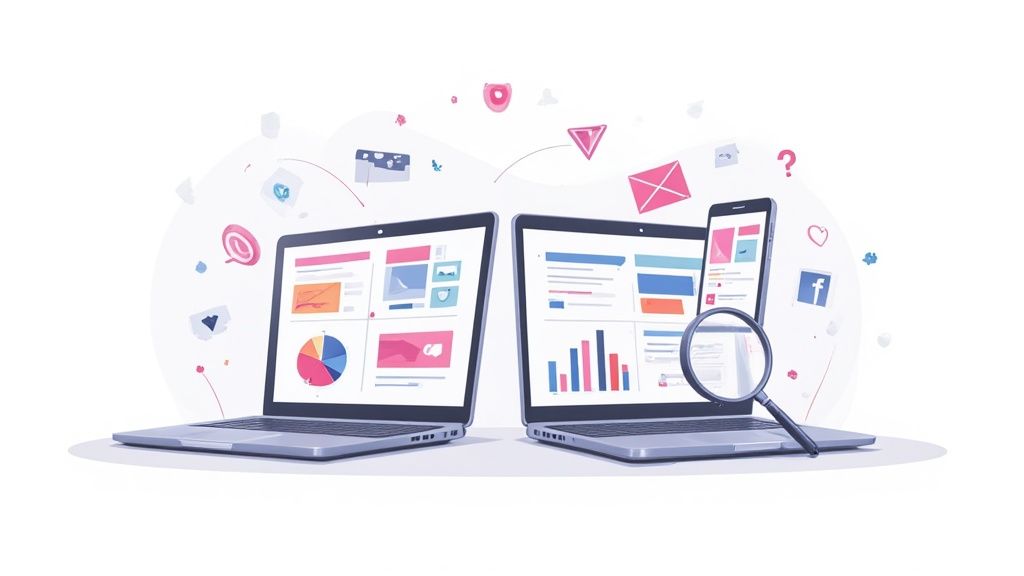Social media success isn’t about guesswork; it’s about data-driven strategy. The right analytics tool transforms raw numbers into actionable insights, revealing what resonates with your audience, how your brand stacks up against competitors, and where to invest your resources for maximum impact. But with a sea of options, how do you choose the one that fits your specific needs without endless free trials and frustrating onboarding?
This guide cuts through the noise. We move beyond generic feature lists and marketing jargon to provide a comprehensive, in-depth review of the best social media analytics tools available today. We’ll explore the real-world strengths and weaknesses of each platform, complete with detailed use cases, implementation considerations, and honest assessments of their limitations. You’ll find direct links and screenshots to give you a clear view of each tool in action.
Whether you are a solo content creator tracking engagement, an agency managing multiple client accounts, or an enterprise-level team conducting competitor analysis, this resource is designed to help you make a confident decision. We’ll analyze everything from all-in-one management suites like Sprout Social and Hootsuite to specialized platforms like Rival IQ and BuzzSumo. Our goal is simple: to provide the clarity you need to select the perfect analytics partner, helping you measure what matters and elevate your social media strategy from the ground up. Let’s dive in and find the right tool to turn your social data into decisive action.
1. Sprout Social: The All-in-One for Polished Reporting
Sprout Social positions itself as a comprehensive social media management suite, but its strength as one of the best social media analytics tools lies in its ability to generate polished, presentation-ready reports with minimal effort. It excels at consolidating cross-channel data into clean, interactive charts that are easy for stakeholders to understand. This makes it ideal for agencies and internal marketing teams who need to quickly demonstrate ROI without spending hours formatting spreadsheets.
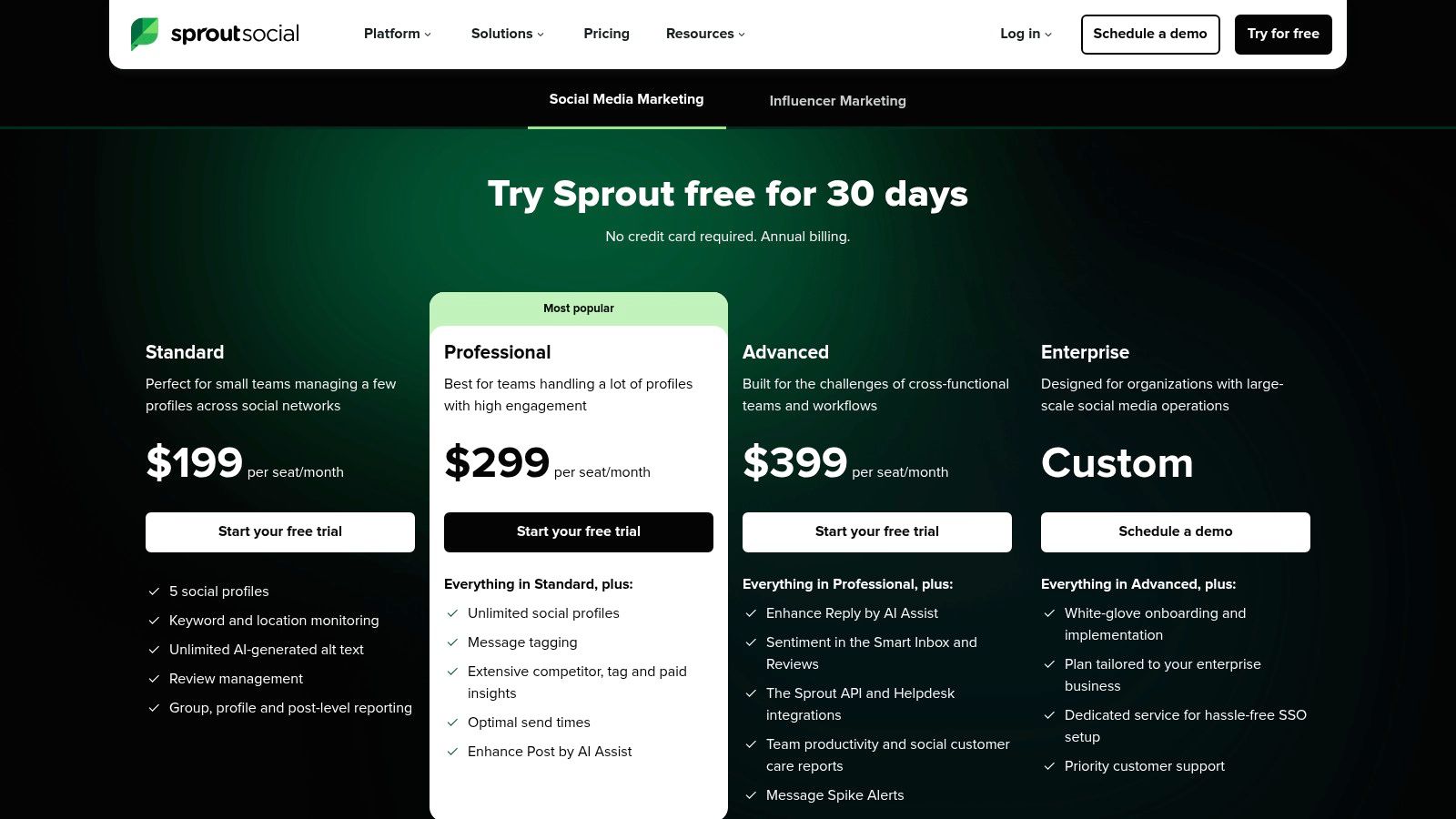
Unlike tools that focus purely on raw data, Sprout’s user experience is designed for clarity and action. The platform provides robust post, profile, and campaign-level analytics, including competitive benchmarking and paid performance insights. A standout practical feature is its Optimal Send Times report, which analyzes your audience’s engagement patterns to suggest the best times to post, directly improving content strategy.
Use Case & Key Considerations
Sprout Social is best suited for teams that need an integrated solution combining publishing, engagement, and analytics. While its core analytics are powerful, be aware that advanced features like deep social listening and premium analytics are available as add-ons, increasing the overall investment. The platform’s per-user pricing model can also become costly for larger teams, making it crucial to evaluate during the generous 30-day free trial.
- Pricing: Plans start at $249 per user/month, with custom pricing for Enterprise and add-ons.
- Best For: SMBs and enterprise teams needing a unified platform with executive-level reporting.
- Unique Feature: The ability to share live, interactive report links with stakeholders who don’t have a Sprout account.
2. Hootsuite: The Customizable Hub for Integrated Teams
Hootsuite is one of the most established names in social media management, and its longevity has resulted in a mature, feature-rich platform. As one of the best social media analytics tools, its key strength is the high degree of dashboard customization it offers. Users can build tailored reports from scratch, mixing and matching over 200 metrics and dozens of visualization widgets to create a view that perfectly aligns with their specific KPIs. This makes it an excellent choice for teams who need to monitor a wide array of metrics simultaneously.
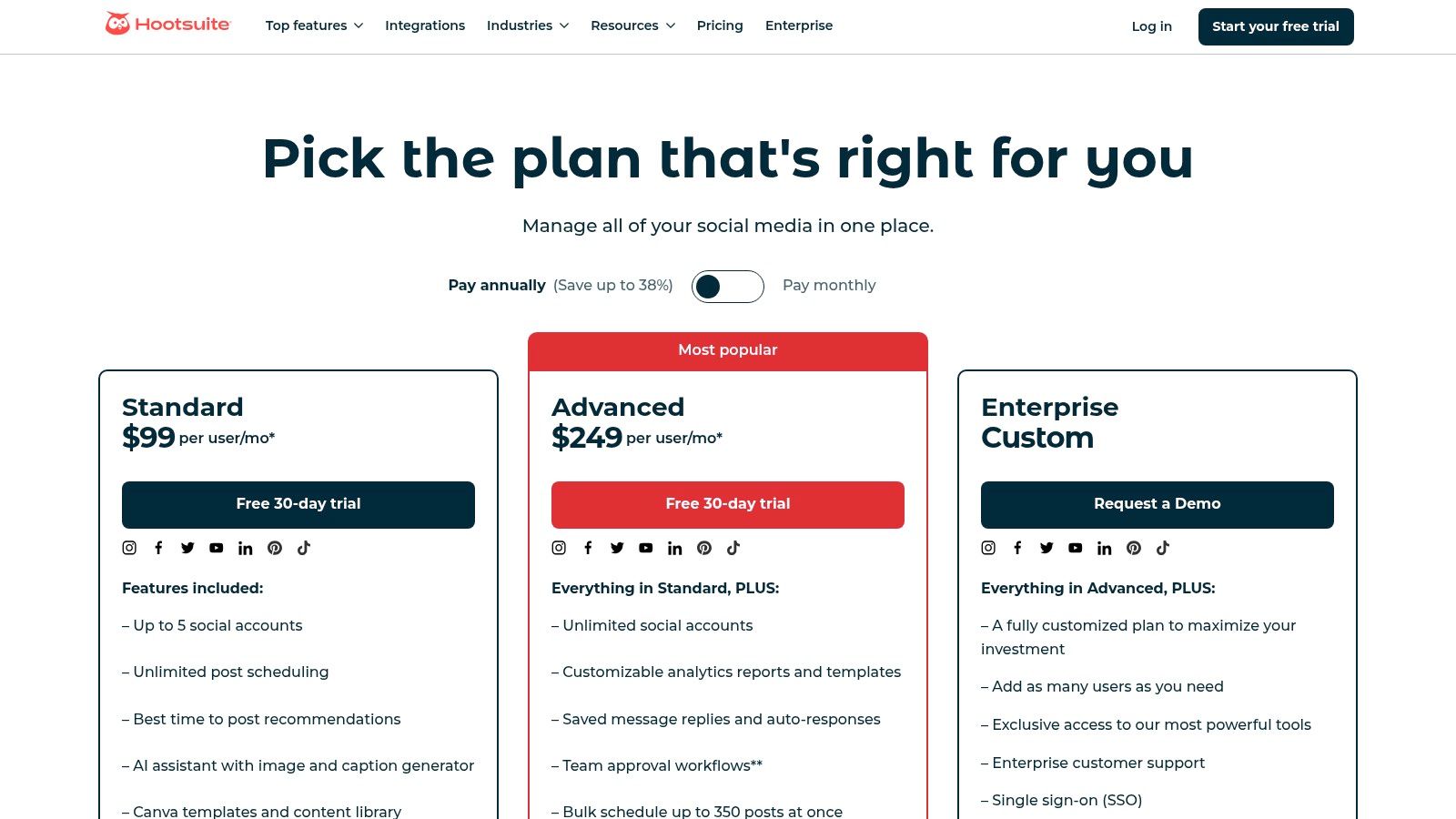
Beyond custom reports, Hootsuite provides powerful, ready-made templates for quick insights. It seamlessly integrates analytics with its robust scheduling and engagement tools, allowing you to measure the impact of your content directly within your workflow. Features like competitor benchmarking and team performance reporting provide a holistic view of your efforts, helping you understand not just how your content performs, but how it stacks up against others and how efficiently your team is working. The platform’s integrated approach is a core part of a strong social media strategy for small business.
Use Case & Key Considerations
Hootsuite is best for teams that value a single, unified hub for scheduling, engaging, and analyzing social media performance. Its all-in-one nature is its biggest draw, but this means that some of its most advanced analytics and listening features are reserved for higher-tier plans. While the platform offers broad channel support, be aware that pricing is not always transparent for all regions and can scale quickly with add-ons and additional users, so a thorough evaluation of your needs against its plan structure is essential.
- Pricing: Plans start at $99 per month, with customized Business and Enterprise solutions available.
- Best For: Marketing teams and agencies needing a single, customizable platform for managing multiple clients or brands.
- Unique Feature: Highly flexible and customizable analytics dashboards that can be built from a library of over 200 metric widgets.
3. Brandwatch Consumer Research: The Enterprise-Grade Listening Engine
Brandwatch moves beyond standard performance metrics, positioning itself as an enterprise-grade consumer intelligence platform. Its power as one of the best social media analytics tools comes from its massive data archive, granting access to over 1.4 trillion historical posts. This allows brands to conduct deep historical analysis, track shifts in consumer sentiment over years, and identify emerging trends before they hit the mainstream. It’s built for strategic insights, not just channel reporting.
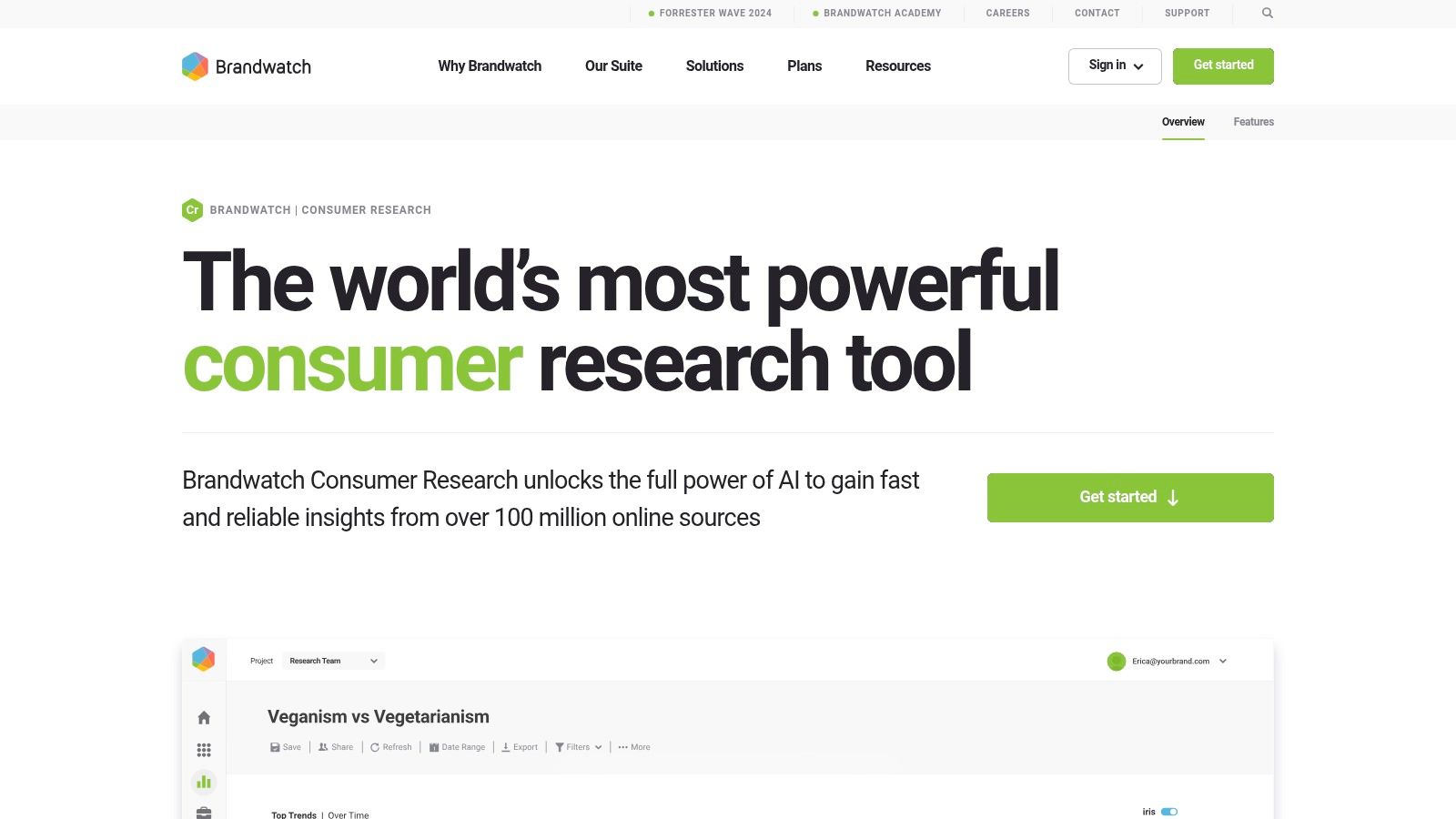
Unlike simpler tools, Brandwatch excels at qualitative analysis at scale. Its AI assistant, Iris, can automatically surface unexpected insights and significant changes in conversation volumes, saving analysts countless hours. The platform also offers advanced image analysis and custom machine-learning classifiers, allowing teams to train the system to spot logos, products, or specific scenes in user-generated content. This level of granular detail is ideal for market research, competitive intelligence, and crisis management.
Use Case & Key Considerations
Brandwatch is best suited for large enterprises and agencies with dedicated research teams that need to answer complex business questions using social data. Its capabilities are likely overkill for small businesses focused solely on their own profile performance. The platform requires a significant investment and a learning curve to master its advanced querying and dashboard-building features. Engagement with a sales representative is required to get a quote, reflecting its enterprise focus.
- Pricing: Custom pricing available upon request after a demo.
- Best For: Enterprise-level market researchers and brand strategists needing deep consumer and competitive insights.
- Unique Feature: The AI-powered assistant (Iris) that automatically analyzes datasets to pinpoint statistically significant conversation drivers and trends.
Visit Brandwatch Consumer Research
4. Sprinklr Social: The Enterprise-Grade Unified Analytics Hub
Sprinklr Social establishes itself as a heavyweight enterprise suite, designed for global brands that require deep, unified analytics across paid, owned, and earned media. Its power as one of the best social media analytics tools comes from its ability to centralize a massive volume of data from over 30 channels into a single source of truth. This platform is built for complexity, allowing large, siloed teams to collaborate within a secure and governed environment.
Unlike point solutions, Sprinklr’s core strength is its breadth and AI-driven insights. The platform’s AI can surface trends, identify potential crises, and provide competitive intelligence automatically, turning raw data into strategic direction. For organizations with complex needs, this ability to create custom metrics and dashboards that align with specific business goals is a significant advantage. Its robust governance features, including SSO and detailed user permissions, are essential for maintaining brand consistency and security at scale.
Use Case & Key Considerations
Sprinklr Social is the ideal choice for large, multinational corporations that need a single, highly configurable platform to manage all customer-facing interactions, not just social media. It’s built to handle extensive data loads and intricate team structures. However, its comprehensive nature means a significant investment and a longer, more involved onboarding process. This isn’t a plug-and-play tool; it requires a strategic commitment to become the foundation of your data-driven marketing strategy.
- Pricing: Custom pricing based on specific modules and usage requirements.
- Best For: Large enterprise teams and global brands needing a powerful, scalable, and unified customer experience platform.
- Unique Feature: Its Unified Customer Experience Management (Unified-CXM) platform integrates modern channels into one cohesive view.
5. Talkwalker: The Enterprise-Grade Social Listening Powerhouse
Talkwalker distinguishes itself among the best social media analytics tools by focusing on deep social listening and comprehensive media monitoring. It moves beyond standard on-platform metrics to scan over 150 million sources, including blogs, forums, news sites, and review sites. This makes it an invaluable asset for large organizations aiming to understand brand perception, track campaign sentiment, and identify emerging trends before they hit the mainstream. Its strength is in turning unstructured conversations into strategic business intelligence.
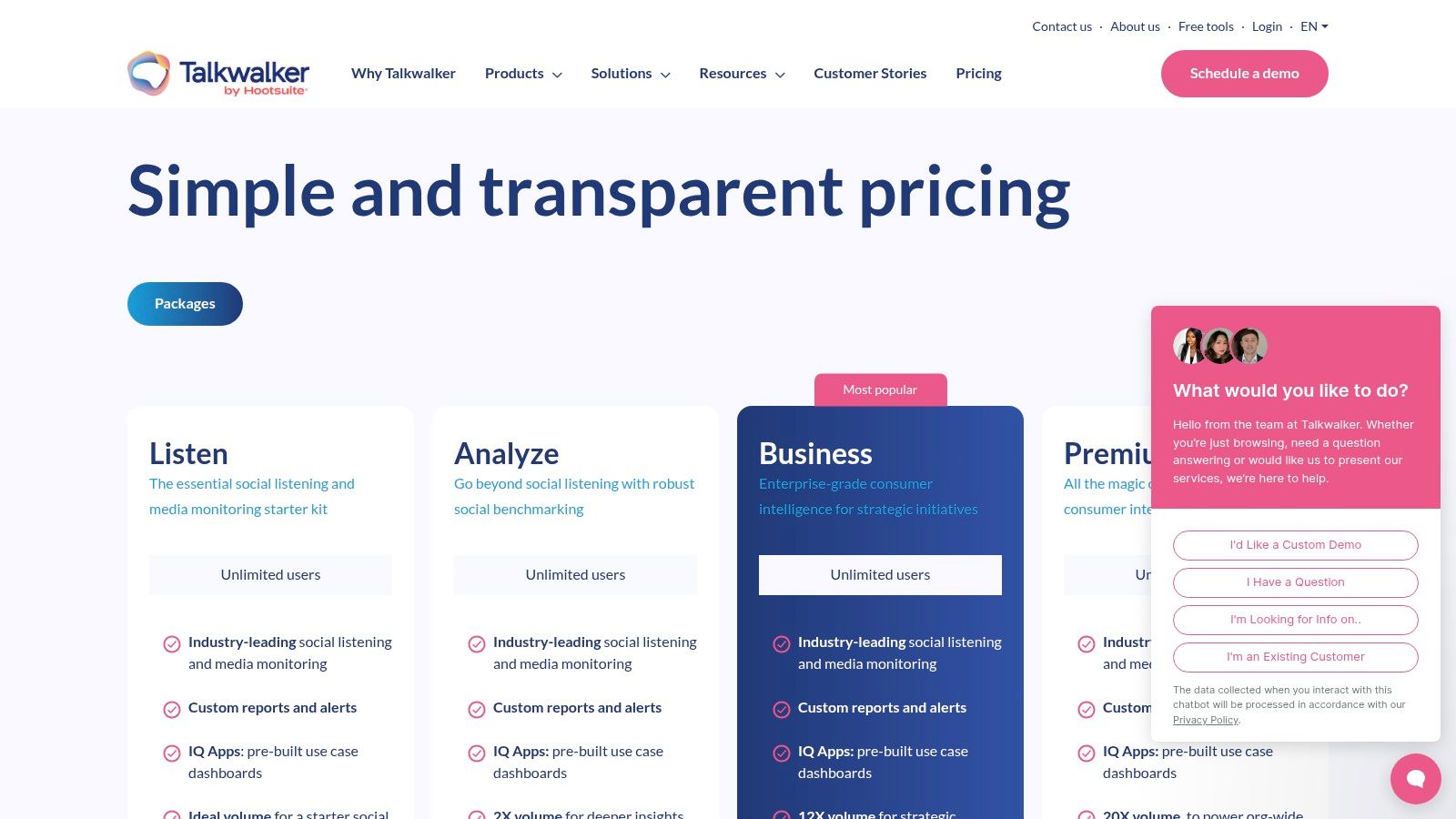
Unlike many competitors, Talkwalker’s platform is built around powerful Boolean query building, allowing for hyper-specific tracking of keywords, themes, and competitor mentions. While this involves a learning curve, it provides unparalleled accuracy. The platform uses AI-powered features to deliver quick summaries and strategic insights from vast datasets, preventing data overload. Custom dashboards and robust, real-time alerting ensure that teams can react quickly to both opportunities and potential crises as they unfold.
Use Case & Key Considerations
Talkwalker is best for enterprises, PR firms, and global brands that prioritize earned media monitoring and competitive intelligence over simple owned-channel reporting. Its unlimited user model is a significant advantage, encouraging adoption across departments like marketing, communications, and product development without incurring extra per-seat costs. However, smaller businesses may find the feature set overwhelming and the mandatory sales process for pricing a barrier. The platform’s true power is unlocked by users willing to invest time in mastering its advanced query and dashboard customization capabilities.
- Pricing: Custom pricing available upon request through a sales consultation.
- Best For: Enterprise-level brands and agencies focused on brand health, crisis management, and market research.
- Unique Feature: Unlimited user seats across all plans, making it highly scalable for large, collaborative organizations.
6. Meltwater: Enterprise-Grade Owned & Earned Analytics
Meltwater extends beyond typical social media analytics tools by offering a unified suite that deeply integrates social listening, publishing, and engagement with powerful analytics. Its core strength lies in its ability to track not just owned and paid media, but also earned media, providing a complete picture of your brand’s digital footprint. The platform is designed for enterprise-level needs, offering customizable dashboards and automated reports that can be tailored for different stakeholders, from marketing managers to C-suite executives.
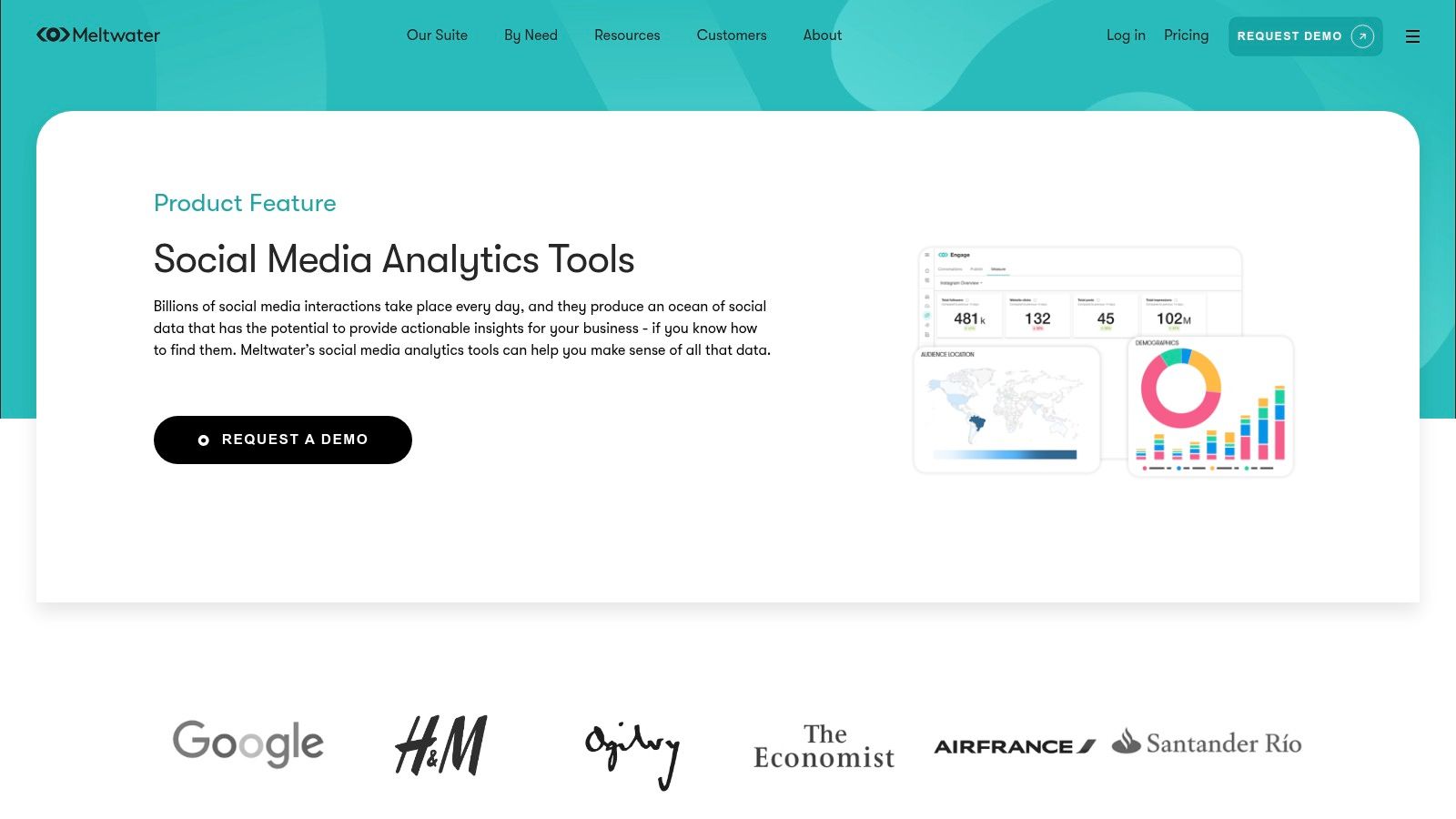
Unlike many platforms focused solely on owned channel performance, Meltwater excels at benchmarking against competitors and analyzing share of voice across the entire web, not just social platforms. Practical features like its comprehensive API and data export options allow for deep integration with business intelligence tools like Tableau or Google Data Studio. This makes it one of the best social media analytics tools for data-driven teams that need to connect social performance to broader business KPIs.
Use Case & Key Considerations
Meltwater is best suited for large organizations and enterprises that require an end-to-end workflow, from content creation to comprehensive earned media monitoring and reporting. Its extensive feature set may be overly complex and costly for small businesses or teams with simple needs. The platform’s lack of public pricing and requirement for annual contracts means the evaluation process is more involved, typically requiring a demo and custom quote.
- Pricing: Pricing is not public and requires a custom quote, typically based on an annual contract.
- Best For: Enterprise teams needing a holistic view of owned, paid, and earned media performance.
- Unique Feature: Robust earned media tracking that quantifies the impact and reach of non-paid brand mentions.
7. Rival IQ: The Ultimate Tool for Competitive Benchmarking
Rival IQ is purpose-built for one thing and does it exceptionally well: competitive social media analytics. While many platforms include competitor tracking as a feature, Rival IQ makes it the core of its platform. It provides unparalleled depth in benchmarking, allowing you to compare your performance against any public social media profile across key metrics like engagement rate, posting frequency, and audience growth. This makes it one of the best social media analytics tools for teams focused on market positioning and outperforming specific rivals.
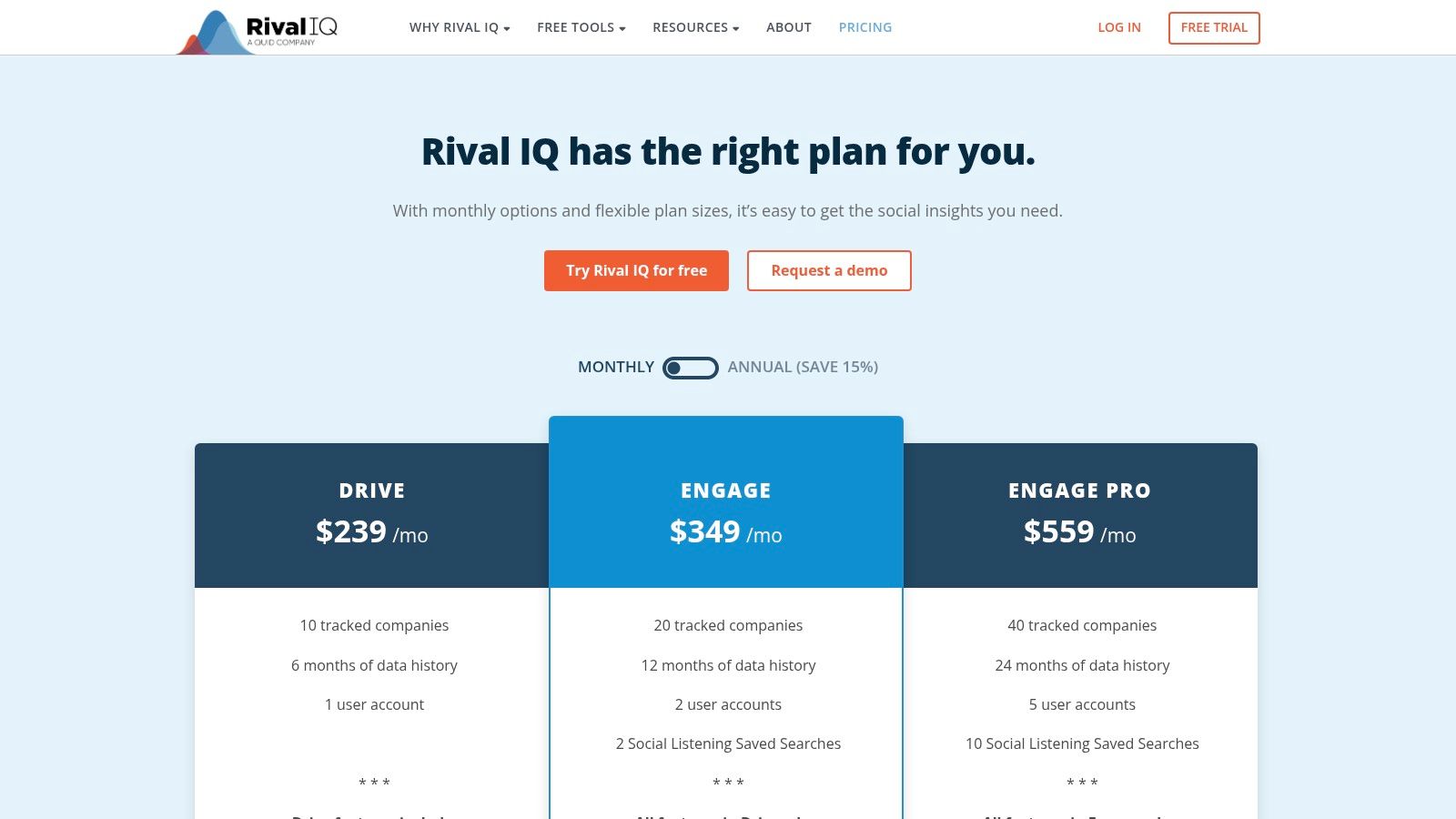
The platform shines with its automated alerts and scheduled reports, which keep you informed of significant shifts in the competitive landscape without requiring you to live inside the dashboard. A practical standout is the ability to analyze competitors’ top-performing content, boosted posts, and content strategies, providing direct inspiration for your own campaigns. It answers the critical question, “What are my competitors doing that works, and how can I do it better?”
Use Case & Key Considerations
Rival IQ is the ideal solution for digital agencies and brand strategists who need to provide clients with a clear, data-driven picture of where they stand in their industry. Its transparent pricing and generous data history are significant advantages. However, it’s important to note the plans limit the number of companies you can track. While it offers listening features, they are not as extensive as dedicated enterprise-level listening platforms, making it more of a direct competitor analysis tool than a broad social monitoring solution.
- Pricing: Plans start at $239/month, with clear feature tiers and a 14-day free trial.
- Best For: Agencies and marketing teams needing deep, actionable competitive intelligence.
- Unique Feature: Detailed competitive alerts that automatically notify you when a competitor has a breakout post or a significant change in performance.
8. Iconosquare: The Visual-First Analytics Powerhouse
Iconosquare has carved out a niche as one of the best social media analytics tools by focusing intensely on visual-centric platforms like Instagram and TikTok. It provides exceptionally deep profile-level analytics, offering metrics far beyond what the native apps provide. This makes it a go-to choice for brands, agencies, and creators whose strategies are heavily dependent on visual storytelling and community engagement on these key channels.
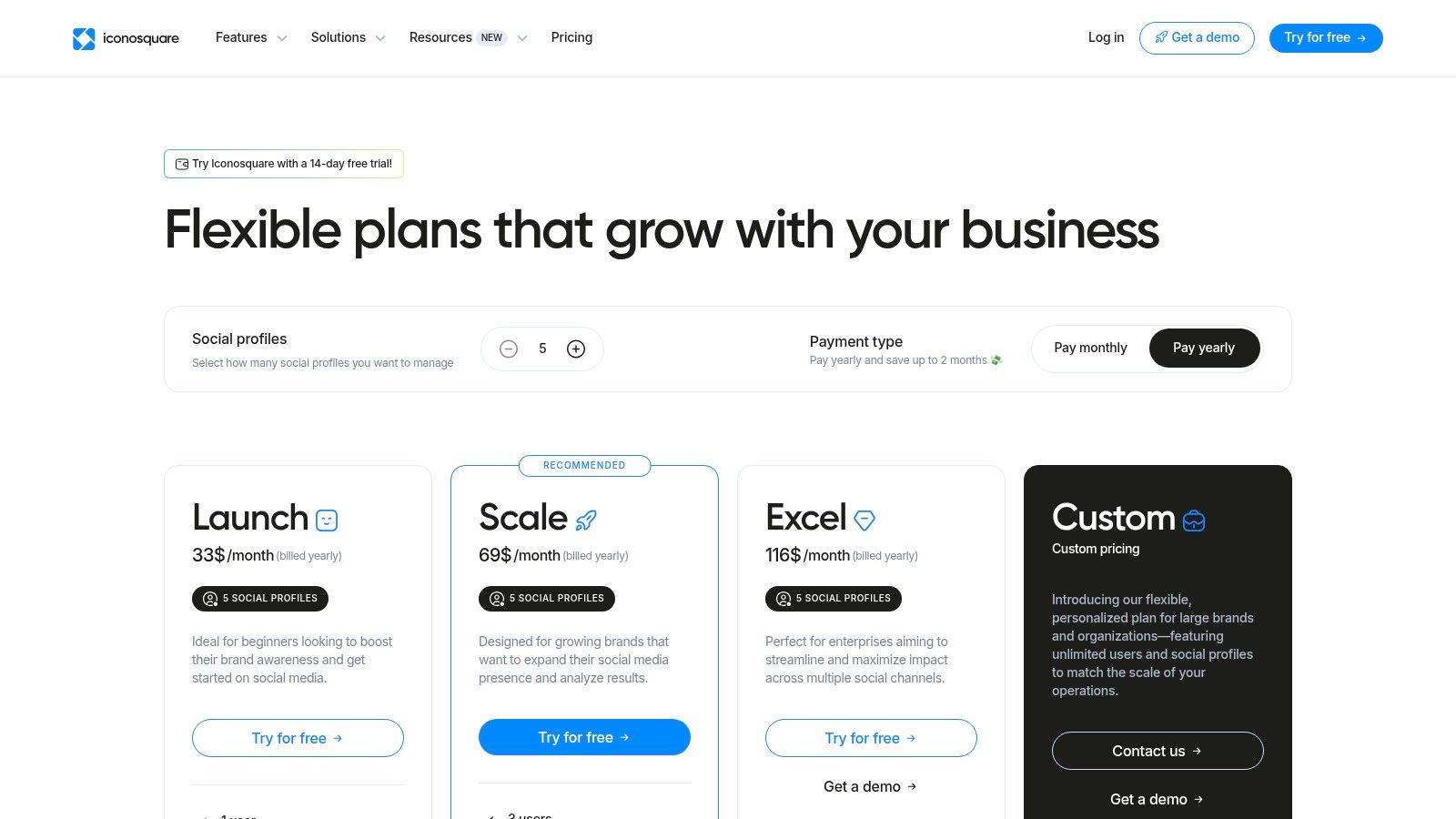
The platform shines with its competitor and industry benchmarking features, allowing you to track your performance against similar accounts with precision. Unlike broader suites, Iconosquare’s interface is streamlined for analyzing visual content performance, from post-by-post engagement breakdowns to audience growth trends. Its Conversation module also helps track comments and mentions, ensuring no user interaction is missed.
Use Case & Key Considerations
Iconosquare is ideal for agencies and social media managers who require detailed, exportable reports specifically for Instagram, TikTok, Facebook, LinkedIn, and Pinterest. Its agency-friendly features, like white-label reporting and user roles, make it highly practical for client management. A key advantage is its long-term data retention, which can be unlimited on higher-tier plans, allowing for historical analysis that many competitors cap. Be aware that pricing is listed in Euros, which may require currency conversion for US-based buyers, and its channel support is more focused compared to all-in-one enterprise platforms.
- Pricing: Plans start at €29/month (billed annually), with multi-profile and agency plans available at higher tiers.
- Best For: Agencies and brands with a strong focus on Instagram and TikTok performance.
- Unique Feature: In-depth hashtag tracking and competitor analytics that provide a clear view of your niche’s landscape.
9. Buffer: The Streamlined Choice for Small Teams
Buffer has long been a favorite for social media scheduling, but it has evolved into a solid contender among the best social media analytics tools, especially for those who prioritize simplicity and affordability. Its analytics suite is designed for clarity, offering straightforward performance overviews, demographic insights, and post-by-post analysis without overwhelming users with data. The platform excels at making core metrics accessible and actionable for small businesses or creators who need to track growth without a steep learning curve.
Unlike complex enterprise solutions, Buffer’s strength lies in its intuitive design and clean reporting. It presents essential data, such as reach, engagement rates, and top-performing content, in a visually appealing format that is easy to export. A key practical benefit is the ability to see individual post analytics directly within the publishing queue, allowing for quick strategic adjustments based on what resonates with your audience. The recent addition of an AI assistant also helps generate content ideas and repurpose successful posts.
Use Case & Key Considerations
Buffer is ideal for small businesses, solopreneurs, and small marketing teams who need an affordable, all-in-one publishing and analytics solution. Its per-channel pricing model is highly flexible, allowing users to pay only for what they need. However, those requiring deep competitive analysis or advanced social listening will find its capabilities limited compared to more specialized tools. The most detailed, branded reports are also reserved for the higher-tier Team plan.
- Pricing: Free plan available. Paid plans start at $6 per channel/month, with the Team plan at $12 per channel/month.
- Best For: Small businesses and individual creators seeking an easy-to-use platform with core analytics.
- Unique Feature: A flexible, per-channel pricing model that makes it exceptionally affordable to start and scale.
10. Later: The Visual-First Tool with Essential Analytics
Later is primarily known as a visual-first social media scheduler, but it earns its spot as one of the best social media analytics tools for creators and small brands who prioritize content performance over deep data dives. It offers a streamlined analytics dashboard focused on the core metrics that matter for visual platforms like Instagram, TikTok, and Pinterest. The platform simplifies performance tracking, making it easy to see which posts resonate without getting lost in complex reports.

Its strength lies in connecting analytics directly to the content creation workflow. For instance, you can review your best-performing posts and immediately use that insight to plan your next visual calendar. Unlike enterprise-level tools, Later’s user experience is built for speed and simplicity, bundling scheduling, a link-in-bio tool, and foundational analytics into one cohesive package. The platform’s Best Time to Post feature is a practical, data-driven tool that directly informs scheduling strategy for maximum reach.
Use Case & Key Considerations
Later is the ideal choice for solo creators, influencers, and small business teams whose social strategy revolves around visual storytelling and who need straightforward, actionable insights. Its analytics provide essential post and profile performance data but lack the advanced competitive benchmarking or social listening found in more expensive suites. A key limitation is the data retention window, which is capped based on your plan (from 3 months to a year), so it may not suit teams needing long-term historical analysis.
- Pricing: A free plan is available. Paid plans start at $25/month, with advanced features in Growth ($45/month) and Advanced ($80/month) tiers.
- Best For: Visual-centric brands, creators, and small businesses needing an integrated scheduling and analytics solution.
- Unique Feature: The comprehensive Link in Bio tool that is fully integrated with its analytics, allowing you to track clicks and sales from your bio link.
11. BuzzSumo: The Ultimate Tool for Content-Driven Analytics
BuzzSumo carves out its niche not as an all-in-one management suite, but as one of the best social media analytics tools specifically for content performance and ideation. It excels at answering the crucial question: “What content resonates with audiences on social media?” The platform allows you to analyze topics, keywords, and domains to see what gets shared the most across networks like Facebook, Twitter, and Pinterest, providing a direct line to proven content strategies.

Unlike platforms focused on your own profile metrics, BuzzSumo’s power lies in its massive index of web content and social engagement data. Its Content Analyzer is a standout feature for competitive research, revealing the top-performing content for any topic or competitor. This data is invaluable for brainstorming viral article ideas, identifying influential authors, and understanding the formats that drive engagement. By focusing on what works across the entire web, BuzzSumo provides a powerful external perspective for your social strategy. To get the most out of this data, you can learn more about how to analyze content performance.
Use Case & Key Considerations
BuzzSumo is best suited for content marketers, SEO specialists, and PR teams who need data to fuel their content creation and outreach strategies. It’s less of a day-to-day social management tool and more of a strategic research platform. While its core content analytics are excellent, be aware that the most powerful influencer discovery and PR-focused monitoring features are reserved for higher-priced plans. The generous 30-day free trial is highly recommended to explore its full capabilities before committing.
- Pricing: Plans start at $199/month, with more advanced features and user seats available in higher tiers.
- Best For: Content marketing and PR teams focused on ideation, competitive analysis, and earned media tracking.
- Unique Feature: The Question Analyzer, which surfaces real questions people are asking online, providing direct inspiration for highly relevant content.
12. G2: The Crowd-Sourced Starting Point for Tool Discovery
While not a tool itself, G2’s Social Media Analytics Software category is an indispensable resource for anyone beginning their search. Instead of relying solely on vendor marketing, G2 provides a meta-level view powered by crowd-sourced user reviews and satisfaction scores. It acts as a comprehensive marketplace, allowing you to filter the landscape of the best social media analytics tools by business size, pricing models, and specific feature sets, making it an essential first step in the evaluation process.
The platform excels at creating context. Its signature Grid reports visually plot tools into quadrants like “Leaders” and “High Performers,” offering a quick assessment of market presence and user satisfaction. This data-driven approach, combined with detailed user feedback on pros and cons, provides a layer of real-world insight that complements official product descriptions. You can quickly see what actual users think about a tool’s ease of use, quality of support, and reporting capabilities.
Use Case & Key Considerations
G2 is best used as a research and shortlisting platform before committing to demos or trials. It helps you build an informed list of potential candidates tailored to your specific needs. However, it’s important to approach the platform with a critical eye. Sponsored placements can influence visibility, and the quality of individual reviews can vary. Always cross-reference high-level scores with the substance of written reviews to get a balanced perspective.
- Pricing: Free to use for research and reviews.
- Best For: Marketing teams and decision-makers in the initial research phase of selecting a new analytics tool.
- Unique Feature: The ability to create side-by-side comparison tables for up to four different tools, directly comparing features and user satisfaction ratings.
Visit G2 Social Media Analytics Category
Top 12 Social Media Analytics Tools Comparison
| Tool | Core Features & Capabilities | User Experience & Quality ★★★★✩ | Value & Pricing 💰 | Target Audience 👥 | Unique Selling Points ✨ |
|---|---|---|---|---|---|
| Sprout Social | Cross-network analytics, reporting, publishing | Clear reports, 30-day trial | Per-seat pricing, add-ons for advanced | SMBs to enterprises | Executive-friendly dashboards 🏆 |
| Hootsuite | Custom dashboards, bulk scheduling, competitor benchmarking | Mature workflows, broad channels | Tiered pricing, regional variation | Teams needing all-in-one tool | Extensive integrations, flexible exports ✨ |
| Brandwatch Consumer Research | AI-powered social analytics, massive data archives | Enterprise-grade, training available | Custom pricing | Large enterprises | AI assistant, image analysis 🏆 |
| Sprinklr Social | Unified paid/earned/owned reporting, governance tools | Highly scalable, strong security | Custom pricing, onboarding required | Global enterprises | All-in-one suite, strong governance 🏆 |
| Talkwalker | Social listening, unlimited users, AI insights | Scalable packages, alerting | Requires sales process | Organizations focused on listening | Unlimited users, AI-driven summaries ✨ |
| Meltwater | Analytics across channels, competitor benchmarking | Stakeholder-ready reports | Annual contracts, custom pricing | Enterprise teams | End-to-end social workflow support ✨ |
| Rival IQ | Competitive metrics, alerts, API add-on | Transparent pricing | Clear plans, per tracked company limits | Competitor-focused analysts | Pricing transparency, Looker Studio connector ✨ |
| Iconosquare | Profile & competitor analytics, white-label reporting | Agency-friendly, data retention | EUR pricing, premium plans expand features | Brands & agencies | Deep Instagram/TikTok focus, white-label ✨ |
| Buffer | Publishing, engagement inbox, AI assistant | Easy setup, clean reports | Low cost, per-channel pricing, free plan | Small teams | AI assistant included, scalable plans 💰 |
| Later | Scheduling, basic analytics, social inbox | Simple onboarding, visual content focus | Straightforward pricing | Creators, small brands & agencies | AI content tools, bulk scheduling ✨ |
| BuzzSumo | Content analytics, influencer ID, social shares | Strong ideation support, easy exports | Higher tiers for full features | PR & content marketers | Trending topics, influencer databases ✨ |
| G2 – Social Media Analytics | User reviews, vendor comparisons, pricing visibility | Crowd-sourced insights | Free access | Buyers researching tools | Leader grids, detailed filters ✨ |
Making Your Final Choice: Strategy Before Software
Navigating the landscape of the best social media analytics tools can feel overwhelming. We have explored a wide spectrum of platforms, from comprehensive enterprise solutions like Sprinklr and Brandwatch to agile, user-friendly options like Buffer and Later. Each tool presents a unique combination of features, strengths, and ideal use cases, reinforcing a critical truth: the “best” tool is not a universal title but a subjective one, entirely dependent on your specific needs.
Your final decision should not be driven by the longest feature list or the most attractive dashboard. Instead, it must be anchored in your core business strategy. The most powerful software in the world is ineffective without a clear plan for how to use the data it provides. Before you start a free trial or request a demo, take a step back and revisit your foundational objectives.
Recapping Key Tool Categories
To help narrow your focus, let’s categorize the tools we have discussed based on their primary strengths:
- All-in-One Management Suites (for scale and integration): Platforms like Sprout Social and Hootsuite excel at unifying publishing, engagement, and analytics. They are ideal for teams that need a central hub to manage multiple profiles and streamline workflows, offering robust reporting that connects social activities to business outcomes.
- Deep Listening & Consumer Intelligence (for market research): If your goal is to understand brand perception, track industry trends, and uncover consumer insights, tools like Brandwatch and Talkwalker are unparalleled. They go beyond simple metric tracking to analyze conversations across the web, providing a rich source of market intelligence.
- Competitive Analysis Specialists (for benchmarking): For marketers who are laser-focused on outperforming the competition, Rival IQ offers exceptional value. Its strength lies in detailed, side-by-side comparisons that make it easy to benchmark your performance and identify strategic opportunities.
- Content & Influencer Discovery (for strategic ideation): BuzzSumo stands out for its ability to identify high-performing content and key influencers in any niche. It is less about your own profile’s metrics and more about understanding what resonates within your industry, making it an essential tool for content strategy.
- SMB & Creator-Focused Tools (for simplicity and efficiency): Platforms like Buffer, Later, and Iconosquare prioritize ease of use, visual planning, and straightforward reporting. They are perfectly suited for small businesses, solo entrepreneurs, and content creators who need powerful analytics without the complexity or cost of enterprise systems.
A Framework for Your Decision
Making the right choice requires introspection. Use the following questions as a guide to create a shortlist of the most relevant tools for your organization:
- What is your primary goal? Are you trying to increase brand awareness, drive website traffic, generate leads, improve customer service, or conduct market research? Your primary objective will immediately point you toward a specific category of tool.
- What is your budget? Be realistic. A small business does not need the financial commitment of a Sprinklr or Meltwater subscription. Define your budget upfront to filter out options that are not financially viable.
- How large is your team? Consider the number of users who will need access. Tools are often priced per seat, and collaboration features become more critical as your team grows.
- What is your team’s technical skill level? An intuitive interface like Buffer’s is perfect for a team new to analytics, while a data-heavy platform like Talkwalker requires a dedicated analyst to extract its full value.
- Which platforms are most important? If Instagram and TikTok are your core channels, a visually-focused tool like Later or Iconosquare might be a better fit than a more text-centric analytics platform.
Ultimately, choosing from the best social media analytics tools is just the first step. The real work begins when you translate that data into actionable insights and strategic initiatives that drive growth. A tool provides the numbers; a strategy gives them meaning. As you move forward, focus not just on what you are measuring, but why you are measuring it, and what you will do with the answers you find.
Turning complex social data into a clear, effective growth strategy requires expertise. At ReachLabs.ai, we bridge the gap between analytics and action, using data-driven insights to craft and execute digital strategies that deliver measurable results. Let us help you transform your social media intelligence into your biggest competitive advantage. Learn more at ReachLabs.ai.

